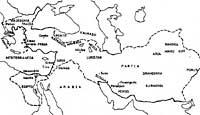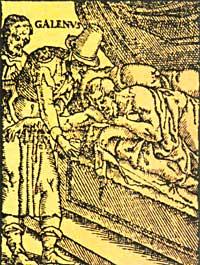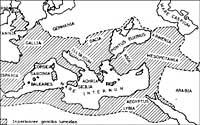The creation of science in Greece. Hellenic age
1986/12/01 Bandres Unanue, Luis Iturria: Elhuyar aldizkaria
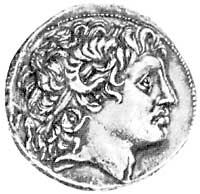
Together with Alejandro Haundia, we can say that we enter a new era of civilization. Earlier, Greek culture spread throughout the Mediterranean, but he, in addition to bringing this culture to the East, intensified relations between Babylon, Egypto and Europe. Incidentally, the accompanying scientists collected and accumulated data on geography and natural science.
Thus began the three centuries of the Hellenic era, the death of Alexander (a. C.). In 323) Augustus began the Roman Empire (a. C.) 31) Throughout these centuries, Greek culture reached its peak in its territory, extending to other countries until it prevailed throughout the known world. Alongside him, the Greek language spread as a cultural instrument from Italy to Indus and the Roman and Asian Goimailes assimilated Greek philosophy and life.
After the death of Alexander Haundia his empire dispersed. Among the Greek states created by this dispersion, the most important for our purposes, Egypto, we have Hellenized, because it was he who built the imposing city called Alexandria. Egypto remained under the command of the Ptolemy dynasty and carried the slogan of Egypto during the three centuries that this dynasty lasted. The most outstanding feature of the Ptolomeans is their fondness and passion for their culture: They built the Museum of Alexandria (or place dedicated to the Muses) and the Library, making this city the world capital of science and culture.
New discoveries about nature created a more scientific thought. The atmosphere of that time was quite similar to the current one, although today in the areas where the machines are found they were then admired. But we can say that a certain specialization began. Apart from general philosophical systems and encyclopedic works, they were investigated after separating and delimiting some specific and concrete problems from others. This gave a breakthrough to natural discoveries.
The Hellenic era had two subeties: the first focused on the diffusion and depth of knowledge from the political and philosophical or scientific spheres; the second, exhausted the creative energy, took place the oriental reaction. The Greek-Macedonian world was caught by this reaction and by Rome. Finally, after overthrowing the Hellenic state system upside down, Rome assumed responsibility and the motto of Greek culture.
The Greek element predominated in Hellenistic culture. However, there were other elements. Babylon's astrology spread through Greek translations and, with it, through the nightmares of California astrology. According to this, the bodies that move in the sky (the macrocosm) direct human functions and the future (the microcosm). From there came the compact of "Azar" and the tendency to worship the stars.
While astrology and magic were established in all human beings, philosophy and science remained for all. The most important philosophical school of the time is Stoicism. Cyprus Zenon a.C. Around the year 317 began to discover what later would be Roman philosophy. Although at the level of theory Stoicism was based on both its logic and its ethics in physics, it actually had little relation to physical science. Perhaps the greatest result of this school is the importance and value it gave to morality.
In the history of science the system of Epicurus is more important than this, since, despite being a philosophical system, it was based on the atomism of Democritus, thus keeping alive the atomistic system until the arrival of Lucrezio. The latter introduced this system into his Poem and provided him with a safe haven forever.
Epicurus of Samos, a.C. He was born in 342 and died in Athens in 270. He presides over a reaction against the idealist philosophy of Plato and Aristotle. This reaction meant a certain dualism between body and mind. In Epicurus' view, everything that exists has a body, although there are things as small as atoms, in which our senses are not able to listen properly. There are also gods, but these are also the results of Nature and not its creators; they live with total tranquility and happiness and we do not have to have any hope or fear of worship.
The only proof of reality is feeling; ideas are only images. Nature consists of atoms and vacuum. And our world, in an unfinished time and in a space without borders, is only that surfaced by chance among all combinations of atoms.
Man is not guided by the gods or by the union of chance, he is as free as he believes and can be freed from external influences to live as god. Thus, the tranquility of the heart can have a deep happiness. Epicurus built an optimistic system using atomics theory and rationalism.
Geometry
If Aristotle had given more importance to deductive reasoning than to inductive reasoning, the greatest success of Greek intelligence in its time is by its deductive geometry and not by any other.
According to the same name of geometry, it arises from the need for surveying, which in no case was Egypton, since periodic flooding of Nile eliminated the limits of the crop fields. Therefore, Egypto was the leader in this field. According to tradition, Talesi de Mileto, the oldest Ionian philosopher, went to visit the Egypto and came up with the idea of an ideal science of space and appearance based on the empirical rules of surveying.
Later, Pythagoras and his students, with new theorems and a logical arrangement of those who knew each other, made a great advance to this field of Science. BC. Around 320, Eudel of Rhodes wrote the history of geometry. Only a few fragments of this work have reached us. However, you can know how the process of building geometry was.
Euklides of Alexandria deserves a special place. This B.C. By the year 300 and after gathering all the achievements and discoveries on the geometry of that time, based on a few axioms on space that were fully noticed, I deduced by logical reasoning the rest of mathematics and geometry, obtaining a coherent and complete body. This geometry is currently studied, and although non-euclidic geometries are admitted, in everyday problems it is the same. Greek geometry, along with modern experimental sciences, must be considered one of the greatest achievements of human intelligence.
Mechanics
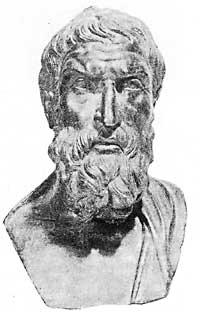
The beginnings of hydrostatics and mechanics, more than in the works of philosophers, must be sought in the practical arts, but studying with deductive methods learned through geometry obtained through the practical arts, it can be said that this branch of science began. What we know is that the first to do so was Archimedes of Syracuse. A. C. He lived between 287 and 212. In his immense work he combined mathematics with experimental research: in this combination definite, precise and limited problems are studied; after proposing some hypotheses, his logical conclusions are extracted to see and verify his conformity with reality.
Archimedes clearly explained the concept of relative density of bodies and the principle that bears his name. They say that when King Hieron ordered the construction of his crown he abandoned a quantity of gold, but it was suspected that all the gold they gave him was used by the Coronists. He then asked Archimedes to verify this situation. Archimedes, in the bathroom, had the intuition of his own princess, but to know if that intuition was true, he removed it mathematically and demonstrated it based on the basic concept of the fluid.
Archimedes took charge of the lever known two thousand years earlier and built a theory on it. To develop this theory, Archimedes had to resort to clearly visible axioms or proposals that could contrast simple experiments.
Archimedes' greatest concern was pure geometry. For him, his greatest achievement was the discovery of the relationship between the volume of a cylinder and the inscribed sphere. To achieve this he had to measure the length of the circumference. For this purpose he used polygons that inscribe the circumference and that are circumscribed. Increasing the number of sides of these polygons, they eventually become almost circumferences.
Thus, it showed that the relationship between the circumference and its diameter was greater than 3 10/71 and less than 3 1/7 (it should not be said that this is the number of _). But it did not give importance to other mechanisms that have given fame to his name (composite pulley, hydraulic screw, etc. ).
Archimedes was not one of these pickers. In his writings he gave us above all the findings obtained by him. And we have to say that it is the best honesty given by the ancient world.
Astronomy
BC. IV. In the 20th century, geographical discoveries were important. Hannon overcame the pillars of Hercules and descended the West African coast. Piteas, encircling Britain, headed toward the polar seas, relating the phases of the Moon to the tides. It was suspected that the Earth was spherical and there was some idea about its actual volume. These advances did not conform to the ideas of the backlight invented by Filolao or central fire, and these parts of Pythagorean astronomy went to the peaks.
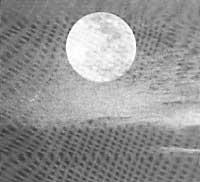
However, Ekfanto, one of the last Pythagoreans, built a simple theory to express the relationship between day and night duration based on their latitude. According to this, the Earth revolved on its axis in the center of space. Heraklides of Pontus, a. C. Around 350. The Sun and the great planets revolve around the Earth, but Mercury and Venus revolve around the Sun.
Aristarchus of Samos He lived between the years 310 and 230. It is therefore contemporary of Archimedes, and in his work that has been acquired ("On the distances of the Sun and the Moon") he used a very suitable geometry to solve the problems that the name indicates. For this, he analyzed the phenomena that appear when there is an eclipse of the Moon and concluded that the relationship between the diameters of the Sun and the Earth should be greater than 19/3 and less than 43/6 (that is, of approximately 7/1), comparing these phenomena with those that the Moon is in the center of its totality. This relationship found is much less than the real one. However, it is a good basis for research and talking about the diameter of the Sun and the Earth and recognizing that the Sun is greater than the Earth, it was a very big step in its time.
According to Archimedes, another hypothesis of Aristarchus is: "As the fixed stars and the Sun stand, the Earth rotates into a circle around the Sun and the Sun would be at the center of this circumference." Plutarch also says that this theory corresponds to Aristarchus. Aristarchus would suppose that to express the stillness of fixed stars, their distances had to be far superior to those of the Earth's orbit.
This heliocentric structure of Aristarchus was too progressive in his time. Therefore, even if one or another philosopher accepted it, most rejected it. While some considered the Earth to be at the center of the Universe, others considered that the solid mass fixed and stable without background was like the senses. The "common senses", on the one hand, and the "voice of most philosophers" on the other, assumed the predominance of geocentric theory.
As we know, a. C. Around the year 370 Eudox of Znidos expressed the apparent movements of the Sun, the Moon and the planets transported in the glass spheres with the Earth in the center. Based on this theory, the following astronomers were able to construct the geocentric theory. BC. In the year 130 Hipparchus shaped him, later Ptolemy of Alexandria d.C. By 150 it would take it to its peak and the XVI. this geocentric theory would continue until the 20th century.
Hipparchus, born in Nice in Bithynia, worked first in Rhodes and then in Alexandria. Despite being only part of his writings, Ptolemy left us all his work. Hipparchus used many of the celebrities of Babylon and ancient Greece; he invented countless astronomical tools that allowed him to make quite precise observations.
Among other things, he calculated that the distance to the Moon was 33 2/3 times the diameter of the Earth (actually 30.2) and that its diameter was one third of the Earth (actually 0.27). Inventor of trigonometry both launa and spherical, showed how any point of our planet is fixed through its latitude and longitude.
Hiparco's greatest vacuum in cosmogony was the basis he recognized, that the Earth was the center of the Universe. However, on the other hand, he achieved enormous success in the manifestations of the observed phenomena. Hiparco said: Taking the Earth as the center, one could express the apparent movements of the Sun, the Moon and the planets, if each of them went through a circumference (epicycle) that moved in its entirety in another much larger radius circumference.
By direct observations the positions and sizes of these cycles and epicycles could be known: at any time tables were constructed that allowed to know in advance the positions of the Sun, the Moon and the planets, and accurately predicted the eclipses of Sun and Moon. The conclusions of this theory were used over the years and although later as an astronomer it was much more popular than Ptolemy Hiparko, the basis of the theory and conclusions of the previous one corresponds to Hiparko.
To finish this stage, it seems legitimate to look back at the School of Alexandria. This school studied four sections: literature, mathematics, astronomy and medicine. In addition to teaching each of these departments, it functioned as a research institute today and there was the largest library in the world of the time, with 400,000 copies. Unfortunately, the IV of our era. In the eighteenth century the Christian bishop Theophilus destroyed part of the library and the remaining one, the mahomatologists, after taking Alexandria, did the same. This loss is one of the greatest massacres in the history of culture.
In addition to some of the scientists observed in this article (Euklides, Hiparko, etc.) in this school also passed other illustrious men: Herophile, Erasistrate and Heron, for example. The influence of this School on the development of science was extraordinary and lasted until the Roman era, but we will analyze it in another article.

Gai honi buruzko eduki gehiago
Elhuyarrek garatutako teknologia




